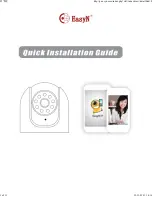
5
Cable Management
When connecting your cables:
1. Never place strain of any kind on the network cable connection.
It’s designed
to clip into place to prevent slippage, but it won’t support any weight and can
easily be broken by a sharp tug. Exercise caution.
2. Ensure that all cables are sheltered from moisture, weather and sunlight.
The network cable connection was designed and intended for indoor use with
computer networking - while it’s ideal for handling the massive data loads that
network cameras require, it’s not weatherproof. The use of conduit piping, silicone
sealant and intelligent placement under shelter are highly recommended.
We recommend installing the camera cable into a location sheltered from the
weather - in addition to making cable management significantly easier, it also has the
advantage of prolonging the life of the camera - while the camera is sealed, robust
and able to handle the weather, long-term exposure to temperature fluctations,
direct sunlight (particularly UV) and moisture will eventually cause a degradation in
performance.
There are some times however, that it’s essential to mount a camera somewhere with
no protection from the elements and nowhere to tuck the cable out of harms way. If
that’s the case for your application, then read below.
Optional: Advanced Users ONLY
The Waterproof Plug Cover:
If you’re comfortable terminating RJ45 cable, then you
can install the waterproof plug cover.
1. Slip
an unterminated segment of RJ45 through the waterproof plug cover.
2. Terminate
the RJ45 with a network plug.
3. Insert
the screw thread into the other side of the plug cover, and
twist
to secure.
Note:
This is an advanced procedure, no matter how simple that diagram looks.
We can’t guarantee or warrant any modified cables or connections.
Note:
If you are using the supplied CAT5E cable we recommend you seal the
camera connection with electical tape, shrink tube or silicone sealant to prevent the
connection deteriorating from moisture entering the pins.
1
2
3






























